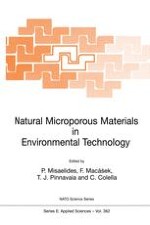1999 | OriginalPaper | Chapter
Heterogeneous Catalysis at Supercritical Conditions Using Microporous Materials. Environmental Advantages
Author : G. Manos
Published in: Natural Microporous Materials in Environmental Technology
Publisher: Springer Netherlands
Included in: Professional Book Archive
Activate our intelligent search to find suitable subject content or patents.
Select sections of text to find matching patents with Artificial Intelligence. powered by
Select sections of text to find additional relevant content using AI-assisted search. powered by
Supercritical fluids possess unique properties that make them attractive as media for chemical reactions. Densities of supercritical fluids are comparable to those of liquids and therefore their dissolving power is high. On the other side diffusion coefficients of components in supercritical fluids are much higher than in liquids. Therefore processes that are mass transfer limited in the liquid phase, like the majority of heterogeneous catalysed reactions on microporous materials, become faster at supercritical conditions. Supercritical fluids have the potential to replace toxic organic solvents and make reaction processes environmentally friendly. This paper discusses some environmental applications of catalytic reaction processes at supercritical conditions.The enhanced maintenance of catalytic activity of zeolites and other microporous catalysts, that could enable them to overcome the obstacle of strong deactivation and replace liquid acids, that are used now and are very toxic, corrosive and pose high safety risk. A second example is the Fischer-Tropsch synthesis of liquid hydrocarbons, a process that would enable the production of liquid fuels from huge reserves of natural gas. That would make more economical and environmentally friendly use of natural gas than now. Hydrogenation over microporous catalysts containing precious metals is another only recently studied process. Hydrogenation in supercritical CO2 enhances dramatically the process safety, reduces the reactor size and increases the reaction rate too, due to enhanced solubility of H2 in supercritical CO2 compared to conventional solvents. Finally a novel wastewater treatment, catalytic supercritical water oxidation, takes advantage of the dramatic change of supercritical water properties compared to liquid water.
